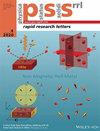Light Logic Gates with GaAs‐Based Structures
IF 2
4区 物理与天体物理
Q3 MATERIALS SCIENCE, MULTIDISCIPLINARY
引用次数: 0
Abstract
The novel XOR, OR, and NAND optical logic gates have been investigated using GaAs‐based Hot Electron Light Emission and Lasing in Semiconductor Heterostructures (HELLISH) devices. The HELLISH devices are fabricated in the Top Hat Hot HELLISH (TH‐HELLISH) geometry to achieve a non‐linear potential distribution at the p‐n junction which consists of a 13 nm thick GaAs quantum well placed on the n‐side of the junction. Logic gates whose input part is designed as an electric field output beam incorporate four independent contacts to the p‐ and n‐type layers. Electroluminescence measurements of the output beam are performed by applying a pulsed voltage of approximately 150 V with a pulse width of 200 ns and a frequency of 20 kHz to the contacts of the TH‐HELLISH device. At room temperature, the primary emission wavelength of the optical logic gates is around 840±1 nm. It is expected that optical logic gates obtained using this type of GaAs semiconductor structure have crucial potential to be components for high‐speed optical communication technology due to their simplicity, polarity‐independent operation, and emission wavelength.This article is protected by copyright. All rights reserved.采用砷化镓基结构的光逻辑门
我们利用基于砷化镓的半导体异质结构(HELLISH)器件中的热电子发光和激光,对新型 XOR、OR 和 NAND 光逻辑门进行了研究。HELLISH 器件采用顶帽热 HELLISH(TH-HELLISH)几何结构制造,以实现 p-n 结处的非线性电势分布,p-n 结由放置在结 n 侧的 13 nm 厚 GaAs 量子阱组成。逻辑门的输入部分被设计为电场输出束,它与 p 型和 n 型层之间有四个独立的触点。输出光束的电致发光测量是通过向 TH-HELLISH 器件的触点施加约 150 V、脉冲宽度为 200 ns、频率为 20 kHz 的脉冲电压来实现的。室温下,光逻辑门的主发射波长约为 840±1 nm。利用这种砷化镓半导体结构制成的光逻辑门具有操作简单、与极性无关、发射波长长等优点,有望成为高速光通信技术的重要元件。本文受版权保护。
本文章由计算机程序翻译,如有差异,请以英文原文为准。
求助全文
约1分钟内获得全文
求助全文
来源期刊

Physica Status Solidi-Rapid Research Letters
物理-材料科学:综合
CiteScore
5.20
自引率
3.60%
发文量
208
审稿时长
1.4 months
期刊介绍:
Physica status solidi (RRL) - Rapid Research Letters was designed to offer extremely fast publication times and is currently one of the fastest double peer-reviewed publication media in solid state and materials physics. Average times are 11 days from submission to first editorial decision, and 12 days from acceptance to online publication. It communicates important findings with a high degree of novelty and need for express publication, as well as other results of immediate interest to the solid-state physics and materials science community. Published Letters require approval by at least two independent reviewers.
The journal covers topics such as preparation, structure and simulation of advanced materials, theoretical and experimental investigations of the atomistic and electronic structure, optical, magnetic, superconducting, ferroelectric and other properties of solids, nanostructures and low-dimensional systems as well as device applications. Rapid Research Letters particularly invites papers from interdisciplinary and emerging new areas of research.
 求助内容:
求助内容: 应助结果提醒方式:
应助结果提醒方式:


